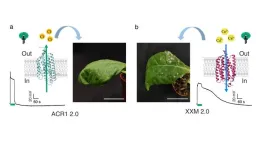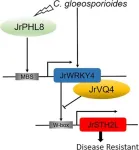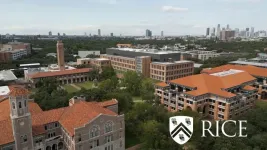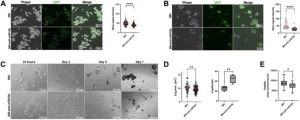(Press-News.org) NEW YORK, NY (Aug. 28, 2024)--An analysis of more than 1.6 million brain cells from older adults has captured the cellular changes that occur in the early stages of Alzheimer’s disease, potentially revealing new routes for preventing the most common cause of dementia in older individuals.
The study also identified a second community of cells that drives the older brain down a different path that does not lead to Alzheimer’s disease.
“Our study highlights that Alzheimer’s is a disease of many cells and their interactions, not just a single type of dysfunctional cell,” says Columbia neurologist Philip De Jager, who led the study with Vilas Menon, assistant professor of neurological sciences at Columbia University Vagelos College of Physicians and Surgeons, and Naomi Habib of the Hebrew University of Jerusalem.
“We may need to modify cellular communities to preserve cognitive function, and our study reveals points along the sequence of events leading to Alzheimer’s where we may be able to intervene.”
Crunching data from 1.6 million brain cells
The study was a technical marvel, cleverly combining new molecular technologies, machine-learning techniques, and a large collection of brains donated by aging adults.
Though previous studies of brain samples from Alzheimer’s patients have provided insights into molecules involved in the disease, they have not revealed many details about where in the long sequence of events leading to Alzheimer’s those genes play a role and which cells are involved at each step of the process.
“Past studies have analyzed brain samples as a whole and they lose all cellular detail,” De Jager says. “We now have tools to look at the brain in finer resolution, at the level of individual cells. When we couple this with detailed information on the cognitive state of brain donors before death, we can reconstruct trajectories of brain aging from the earliest stages of the disease.”
The new analysis required over 400 brains, which were provided by the Religious Orders Study and the Memory & Aging Project based at Rush University in Chicago.
Within each brain, the researchers collected several thousand cells from a brain region impacted by Alzheimer’s and aging. Every cell was then run through a process—single-cell RNA sequencing—that gave a readout of the cell’s activity and which of its genes were active.
Data from all 1.6 million cells were then analyzed by algorithms and machine-learning techniques developed by Menon and Habib to identify the types of cells present in the sample and their interactions with other cells.
“These methods allowed us to gain new insights into potential sequences of molecular events that result in altered brain function and cognitive impairment,” Menon says. “This was only possible thanks to the large number of brain donors and cells the team was fortunate enough to generate data from.”
Aging vs. Alzheimer’s
Because the brains came from people at different points in the disease process, the researchers were able to solve a major challenge in Alzheimer’s research: identifying the sequence of changes in cells involved in Alzheimer’s and distinguishing these changes from those associated with normal brain aging.
“We propose that two different types of microglial cells—the immune cells of the brain—begin the process of amyloid and tau accumulation that define Alzheimer’s disease,” De Jager says.
Then after the pathology has accumulated, different cells called astrocytes play a key role in altering electrical connectivity in the brain that leads to cognitive impairment. The cells communicate with each other and bring in additional cell types that lead to a profound disruption in the way the human brain functions.
“These are exciting new insights that can guide innovative therapeutic development for Alzheimer’s and brain aging,” De Jager says.
“By understanding how individual cells contribute to the different stages of the disease, we will know the best approach with which to reduce the activity of the pathogenic cellular communities in each individual, returning brain cells to their healthy state,” De Jager says.
Additional information
Philip De Jager, MD, PhD, is the Weil-Granat Professor of Neurology at Columbia University Vagelos College of Physicians and Surgeons, where he is also director of the Center for Translational and Computational Neuroimmunology, director of the Multiple Sclerosis Center, and deputy director of the Taub Institute for Research on Alzheimer's Disease and the Aging Brain.
Vilas Menon, PhD, is assistant professor in the Department of Neurology and Taub Institute for Research on Alzheimer Disease and the Aging Brain at Columbia University Vagelos College of Physicians and Surgeons.
The paper, “Cellular communities reveal trajectories of brain aging and Alzheimer’s disease,” was published Aug. 28 in Nature.
All authors: Gilad Sahar Green (Hebrew University of Jerusalem), Masashi Fujita (Columbia), Hyun-Sik Yang (Harvard), Mariko Taga (Columbia), Anael Cain (Hebrew University of Jerusalem), Cristin McCabe (Broad Institute), Natacha Comandante-Lou (Columbia), Charles C. White (Broad Institute), Anna K. Schmidtner (Hebrew University of Jerusalem), Lu Zeng (Columbia), Alina Sigalov (Columbia), Yangling Wang (Rush University Medical Center), Aviv Regev (Genentech), Hans-Ulrich Klein (Columbia), Vilas Menon (Columbia), David A. Bennett (Rush University Medical Center), Naomi Habib, (Hebrew University of Jerusalem), and Philip L. De Jager (Columbia).
###
Columbia University Irving Medical Center (CUIMC) is a clinical, research, and educational campus located in New York City. Founded in 1928, CUIMC was one of the first academic medical centers established in the United States of America. CUIMC is home to four professional colleges and schools that provide global leadership in scientific research, health and medical education, and patient care including the Vagelos College of Physicians and Surgeons, the Mailman School of Public Health, the College of Dental Medicine, the School of Nursing. For more information, please visit cuimc.columbia.edu.
END
A cellular community in the brain drives Alzheimer’s disease
2024-08-28
ELSE PRESS RELEASES FROM THIS DATE:
Plant signaling pathways decoded
2024-08-28
When it comes to survival, plants have a huge disadvantage compared to many other living organisms: they cannot simply change their location if predators or pathogens attack them or the environmental conditions change to their disadvantage.
For this reason, plants have developed different strategies with which they react to such attacks. Such reactions are usually triggered by certain signals from the environment. As has long been known, the intracellular calcium concentration plays an important role in the processing of these signals.
However, in addition to changes in the cytoplasmic calcium level, changes in the cell's ...
Fighting fungal foes: Walnut's genetic armor against anthracnose revealed
2024-08-28
A pivotal study has pinpointed a gene module crucial for enhancing walnut trees' resistance to anthracnose, a widespread fungal disease threatening the walnut industry. The research reveals how the JrPHL8-JrWRKY4-JrSTH2L module regulates disease defense, opening up new opportunities for breeding resistant walnut varieties and promoting sustainable cultivation practices.
Anthracnose, caused by Colletotrichum gloeosporioides, poses a significant threat to walnut production, causing severe losses ...
Rice engineers develop AI system for real-time sensing of flooded roads
2024-08-28
Roadway-related incidents are a leading cause of flood fatalities nationwide, but limited flood-reporting tools make it difficult to evaluate road conditions in real time.
Existing tools — traffic cameras, water-level sensors and even social media data — can provide observations of flooding, but they are often not primarily designed for sensing flood conditions on roads and do not work in conjunction. A network of sensors could improve situational flood level awareness; however, they are expensive to operate at scale.
Engineers at Rice University have developed a possible solution to this problem: an automated data ...
Dr. David A. Schwartz receives 39th annual Alton Ochsner Award
2024-08-28
NEW ORLEANS – Ochsner Health has announced David A. Schwartz, MD, as the 2024 winner of the Alton Ochsner Award Relating Smoking and Disease. Dr. Schwartz is a Distinguished Professor of Medicine and Immunology and director of the Program to Advance Physician Scientists and Translational Research at University of Colorado’s Anschutz School of Medicine.
Dr. Schwartz won the 39th annual Alton Ochsner Award for his research on how genetic and environmental factors, including smoking, contribute to idiopathic pulmonary fibrosis (IPF). He found that ...
New data: Solar at K-12 schools quadrupled nationwide during the last ten years
2024-08-28
Charlottesville, VA — Schools across the country are rapidly switching to solar power to meet their energy needs while gaining significant cost-savings, boosting climate resilience, and supporting workforce development, according to a new report from clean energy nonprofit Generation180. Since the start of 2014, the amount of solar capacity installed at K-12 schools has more than quadrupled nationwide.
According to Brighter Future: A Study of Solar on K-12 Schools, 5th edition, over 6.2 million U.S. K-12 students– or more than one in nine students – now attend a school that utilizes solar power. In 2022-2023, over 800 schools added solar arrays, which is enough ...
Thermochromic material could make indoor temperature control more energy-efficient
2024-08-28
HOUSTON – (Aug. 28, 2024) – Rice University researchers have developed a smart material that adjusts its transparency with changes in temperature, outperforming similar materials in terms of durability, transparency and responsiveness. The new polymer blend could significantly enhance energy efficiency for indoor space cooling, according to a new study published in Joule.
Cooling off can be a matter of life or death, but air conditioning ⎯ when and if available ⎯ already accounts for 7% of the world’s energy use and 3% of carbon emissions. With temperatures hitting record ...
Damon Runyon Cancer Research Foundation awards $4.8 million to exceptional early-career scientists
2024-08-28
The Damon Runyon Cancer Research Foundation has named 16 new Damon Runyon Fellows, exceptional postdoctoral scientists conducting basic and translational cancer research in the laboratories of leading senior investigators. This prestigious Fellowship encourages the nation's most promising young scientists to pursue careers in cancer research by providing them with independent funding ($300,000 total) to investigate cancer causes, mechanisms, therapies, and prevention.
“What is so exciting—and so challenging—about being a postdoc is that you’re called to take what you know and apply ...
Primary care providers urged to assist patients who engage in emotional eating
2024-08-28
August 28, 2024 — Primary care providers are well positioned to address emotional eating because of their long-term relationships with patients, noted Jana DeSimone Wozniak, PhD and Hsiang Huang, MD, MPH, of Harvard Medical School and Cambridge Health Alliance in Cambridge, Massachusetts. According to their article published in Harvard Review of Psychiatry, part of the Lippincott portfolio from Wolters Kluwer, emotional eating is associated with myriad health problems, including the experience of ...
Half of Uber, Lyft trips replace more sustainable options
2024-08-28
More than 50% of ride-hailing trips taken by surveyed riders in California replaced more sustainable forms of transportation — such as walking, cycling, carpooling, and public transit — or created new vehicle miles, according to a study from the University of California, Davis Institute of Transportation Studies.
The study was conducted to help guide development of the Clean Miles Standard, a state regulation designed by the California Air Resources Board to reduce the greenhouse gas emissions from ride-hailing services.
Published in Transportation Research ...
miR-10b Inhibition: A strategy for treating metastatic breast cancer
2024-08-28
“We have developed a nanodrug, termed MN-anti-miR10b, that delivers anti-miR-10b antisense oligomers to cancer cells.”
BUFFALO, NY- August 28, 2024 – A new research paper was published in Oncotarget's Volume 15 on August 26, 2024, entitled, “Inhibition of miR-10b treats metastatic breast cancer by targeting stem cell-like properties.”
As stated within the Abstract of the paper, despite advances in breast cancer screening and treatment, the prognosis for metastatic disease remains dismal, with ...







